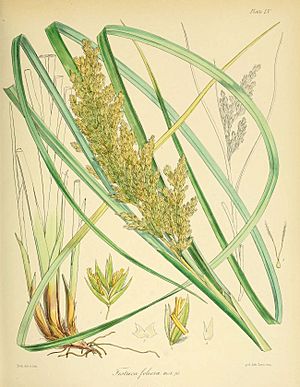Poa foliosa facts for kids
Quick facts for kids Poa foliosa |
|
|---|---|
 |
|
| Plate LV (artist Fitch) | |
| Conservation status | |
|
Invalid status (NZ TCS)
|
|
| Scientific classification | |
| Genus: |
Poa
|
| Species: |
foliosa
|
| Synonyms | |
|
|
Poa foliosa is a type of tussock grass often called muttonbird poa. It grows naturally on the subantarctic islands near New Zealand and Australia.
Contents
About Muttonbird Poa
Poa foliosa is a grass that grows back every year. It forms thick clumps, called tussocks, which can reach up to 2 meters (about 6.5 feet) tall. This plant has separate male and female parts on different plants.
The tussocks grow from short, woody underground stems called stolons. The bottom parts of the shoots are covered by tough, leftover leaf bases. Its leaves are usually 150–400 millimeters (about 6–16 inches) long and 3–6 millimeters (about 0.1–0.2 inches) wide.
Life Cycle
This grass flowers from October to December. It then produces fruits from November to April.
Where It Lives
In New Zealand, you can find this grass on the north-eastern Muttonbird Islands. It also grows on the Solander, Snares, Antipodes, Auckland, and Campbell Islands.
It is also found on Australia's Macquarie Island. This grass usually lives near the coast, often close to where many seabirds nest.
Macquarie Island Habitat
On Macquarie Island, Poa foliosa grows on coastal areas and slopes. It often grows with another plant called Stilbocarpa polaris where the ground drains well. You can also see it along the edges of streams.
It forms tall tussock grasslands along the beaches, above the high-water mark. You can also find patches of it on the island's plateau, in both sheltered and windy spots. These grasslands in the uplands are important homes for petrels that nest in burrows, as well as for rabbits and mice.
When rabbits are controlled, the tall tussock grasslands of Poa foliosa spread out more.
How It Was Named
The first time this plant was described was in 1845. It was named Festuca foliosa by Joseph Hooker. Later, in 1864, he changed its name and placed it in the group of plants called Poa.
Protecting This Grass
In both 2009 and 2012, experts in New Zealand said that Poa foliosa was "At Risk - Naturally Uncommon." This means it's not very common because it only grows in a few places. This classification was confirmed again in 2018. They also noted that it is safe in other countries.

